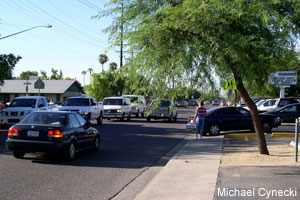All Drivers Near the School

Roadrunner Elementary School, Marana, AZ.
Many parents, community members and school personnel drive near the school on most weekdays. Each driver can contribute to or detract from the safety of the walking and bicycling environment for children. Failure to comply with traffic laws and posted speed limits are examples of driving behaviors that result in unsafe conditions.
A National Safe Kids study of 27 cities found that of the vehicle speeds recorded during the 30 minutes before and after school, 65 percent of drivers exceeded the posted speed limit with 23 percent of these drivers traveling at least 10 mph above speed limit and 33 percent traveling 30 mph or more beyond the limit (National SAFE KIDS Campaign, 2000).
The need to reduce the number of speeders and the speeds at which they travel is crucial to ensure the routes to school are safe. As vehicle speed increases so does the pedestrian injury severity and the likelihood of death. A pedestrian struck by a vehicle moving 20 mph has a 5 percent chance of dying. As vehicle speed increases to 30 mph and 40 mph, the likelihood that the pedestrian will be killed increases to 45 percent and 85 percent respectively (U.K. Department of Transportation, 1987; Pasanen & Salmivaara, 1993). Slowing vehicle speeds not only reduces the chance of a pedestrian-vehicle collision because of the reduced stopping distance required, but it also reduces the chance of a pedestrian fatality or serious injury.
Along with speeding, failure to comply with stop signs and traffic signals also contributes to unsafe environments. A National Safe Kids study on driver behavior at intersections in school zones and residential neighborhoods found that 45 percent of drivers failed to completely stop at the intersection even though a stop sign was present, and of these, 7 percent did not even slow down for the sign. Although the study found that drivers were more likely to stop when a pedestrian was present compared to not present, 36 percent of drivers violated the stop signs when pedestrians were waiting at the curb to cross and 24 percent of drivers did not come to a complete stop at the intersection while pedestrians were crossing (National SAFE KIDS Campaign, 2004).
Additionally, a study of crosswalks in school zones shows that approximately 30 percent of drivers stopped within or beyond the boundaries of crosswalks, thus blocking the pedestrian path (National SAFE KIDS Campaign, 2003).
Drivers traveling at safe speeds, yielding to pedestrians and cyclists, and stopping at stop signs and crosswalks help create a pedestrian and bicyclist-friendly environment.
